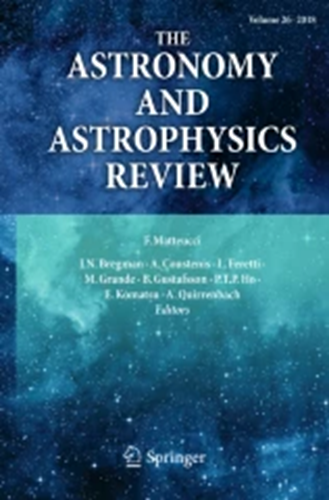Time-dependent properties of sunspot groups. I. Lifetime and asymmetric evolution
IF 26.5
1区 物理与天体物理
Q1 ASTRONOMY & ASTROPHYSICS
引用次数: 4
Abstract
Aims. In this paper, we aim to study the time dependence of sunspot group areas in a large sample composed of various databases spanning over 130 years, used state-of-the-art statistical methods. Methods. For a carefully selected but unbiased sample, we use Bayesian modelling to fit the temporal evolution of the combined umbral and penumbral area of spot groups with a skew-normal function to determine the existence of any asymmetry in spot growth or decay. Our primary selection criteria guaranteed that only spot groups with a well-defined maximum area were taken into account. We also analysed the covariance of the resulting model parameters and their correlations with the physical parameters of the sunspots and the ongoing solar cycle. Results. Our results show that the temporal evolution of well-observed sunspot groups that reach at least 50 millionths of a solar hemisphere (MSH) at their maximum can be fitted surprisingly well with our model. Furthermore, we show significant asymmetry - described by a skew parameter of fitted curves - between the growing and decaying phases of analysed sunspot groups. In addition, we found a weak correlation between the values of skew parameters and the maximum area of sunspot groups and their hemispherical latitude.太阳黑子群的时变特性。1 .生命周期和不对称进化
目标本文采用最先进的统计方法,在130多年的大样本数据库中研究了太阳黑子群面积的时间依赖性。方法。对于精心挑选但无偏的样本,我们使用贝叶斯模型来拟合斑点组的组合本影和半影区域的时间演变与斜正态函数,以确定斑点生长或衰减中是否存在任何不对称性。我们的主要选择标准保证只考虑具有明确定义的最大面积的斑点组。我们还分析了所得模型参数的协方差及其与太阳黑子物理参数和正在进行的太阳周期的相关性。结果。我们的研究结果表明,经过充分观测的太阳黑子群的时间演化,其最大值至少达到太阳半球(MSH)的50万分之一,可以很好地与我们的模型相吻合。此外,我们显示了显著的不对称性-由拟合曲线的偏态参数描述-在分析的太阳黑子群的生长和衰减阶段之间。此外,我们发现偏斜参数值与太阳黑子群的最大面积及其半球纬度之间存在弱相关性。
本文章由计算机程序翻译,如有差异,请以英文原文为准。
求助全文
约1分钟内获得全文
求助全文
来源期刊

The Astronomy and Astrophysics Review
地学天文-天文与天体物理
CiteScore
45.00
自引率
0.80%
发文量
7
期刊介绍:
The Astronomy and Astrophysics Review is a journal that covers all areas of astronomy and astrophysics. It includes subjects related to other fields such as laboratory or particle physics, cosmic ray physics, studies in the solar system, astrobiology, instrumentation, and computational and statistical methods with specific astronomical applications. The frequency of review articles depends on the level of activity in different areas. The journal focuses on publishing review articles that are scientifically rigorous and easily comprehensible. These articles serve as a valuable resource for scientists, students, researchers, and lecturers who want to explore new or unfamiliar fields. The journal is abstracted and indexed in various databases including the Astrophysics Data System (ADS), BFI List, CNKI, CNPIEC, Current Contents/Physical, Chemical and Earth Sciences, Dimensions, EBSCO Academic Search, EI Compendex, Japanese Science and Technology, and more.
 求助内容:
求助内容: 应助结果提醒方式:
应助结果提醒方式:


